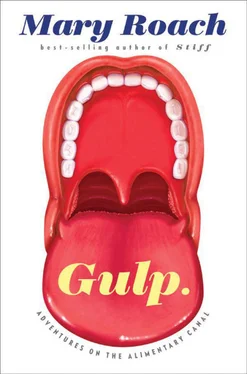In 1752, a French naturalist devised a way to resolve the debate—and, unintentionally, address the inane whale-stomach-survival query of an American author two and a half centuries into the future. René Réaumur owned—or anyway, had access to—a small raptor called a kite. Like most carnivorous birds, the kite regurgitates a pellet of fur and feathers once it has finished with the digestible portions of its prey. This gave Réaumur an idea. He could hide in the kite’s food a small tube carrying meat. The tube would keep the meat from being crushed by the gizzard, and mesh grates at either end would allow stomach solvents, if they existed, to enter and digest it. The kite’s gizzard, taking the tube to be an unusually large, hard bone, would conveniently return it to daylight. If the meat in the regurgitated tube was dissolved, it meant some sort of fluid had done the work of digestion. Réaumur would eventually try this with a variety of barnyard birds. For our purposes, we are more interested in the fate of the tubes than that of the food. Those made from glass were smashed by the contractions of the gizzards, as were the tin tubes that replaced them. Réaumur had to use lead tubes that would withstand close to 500 pounds of pressure before they emerged from a gizzard uncrushed.
To get a sense of what that would feel like—what it would be like inside a gizzard or, by extension, a sperm whale stomach—I did a Google search on “500 pounds of pressure.” That is, among other things, the maximum pressure exerted by the beak of a Moluccan Cockatoo, a bird that can bite off a man’s finger. It’s the force exerted by the footfall of a 130-pound person, which means that being inside a gizzard feels like me stepping on you, perhaps in my haste to escape your cockatoo. And, finally, the American Automobile Association tells us that 500 pounds is the force with which an unrestrained ten-pound dog will hit the windshield in a fifty-mile-per-hour head-on.
And a sperm whale’s forestomach muscles are presumably more powerful than those of a turkey gizzard. I’d say your chances of surviving in a sperm whale stomach are slender. I’d say you’re better off with the Chihuahua in the crashing pickup truck.
The biblical account of Jonah’s travails does not actually use the word whale . It says “big fish.” University of California, Santa Cruz, biologist Terrie Williams once had occasion, as they say, to open the stomach of a sixteen-foot tiger shark. It happened while she was working in Hawaii. A woman had been killed while swimming, not far from where the shark had been caught, and Williams was called in to see if pieces of her might be found inside it. Instead, Williams found three full-grown, manhole cover–sized, intact green turtles, all facing forward. “They never saw it coming. All they knew was like, ‘I’m swimming around and it’s blue, it’s Hawaii, how great is this…’ And the next thing they see is this huge mouth shutting.” And shark stomachs, unlike sperm whale forestomachs, secrete gastric acids and enzymes. Williams thought that the turtles, withdrawn into their protective shells and able to store oxygen in their muscles, might have survived a half day or so.
What about a scuba diver in a wetsuit with a tank of oxygen? How long could he survive in a tiger shark? Christiananswers.net puts forth an intriguing digestive loophole that, were it true, would have worked in his—or for that matter, Jonah’s—favor: “As long as the animal… swallowed is still alive, digestive activity will not begin.”
THIS PERSISTENT BIT of digestive bunk can be traced to eighteenth-century Scottish anatomist John Hunter, an otherwise estimable scientist who more or less invented modern surgery. In the course of hundreds of dissections, Hunter would come across cadavers with mysterious lesions in the stomach wall. He first assumed, reasonably enough, that the lesions had been the cause of death. But the condition was turning up even in vigorous young men killed in brawls, including one man done in by a blow to the head with an iron poker. In this case, too, the man’s stomach was dissolved clear through, Hunter noting that the contents of his supper—cheese, bread, cold meat, and ale—had spilled into the body cavity. There are several things one might take away from this case: that pub fare has changed little in two hundred years; that the owners of drinking establishments would do well to keep the fireplace tools behind the bar. Hunter came away with the realization that the inexplicable lesions he’d been seeing were not disease but auto-digestion. The stomach tissue, he noted, was damaged in the same way the digested cold cuts were. In other words, the stomach, at death, begins to digest itself.
This raised the question, What keeps it from doing so while the person is alive? Hunter’s explanation—and the source of the Christiananswers.net piffle—was that living tissue exudes some sort of vital force field that protects it. “Animals… possessed of the living principle, when taken into the stomach, are not the least affected by the powers of that viscus…,” stated Hunter in a 1772 text. Ditto humans taken in: “If one conceive a man to put his hand into the stomach of a lion, and hold it there,” wrote Hunter in a separate text, “… the hand would not in the least be digested.” A small and temporary consolation, it must be said.
French physiologist Claude Bernard didn’t buy it. Bernard took some animals into the stomach. The year was 1855. The stomach belonged to a live dog and had been given a fistulous opening similar to the one that had enabled William Beaumont to spy on the digestive activities of Alexis St. Martin a few decades (and chapters) earlier. Bernard restrained the dog and then “introduced,” through the fistula, the hindquarters of a frog. After forty-five minutes, the frog’s legs were “largely digested”—nothing new to a Frenchman, except that here the frog was still alive. The experiment, concluded Bernard, “shows that life is not an obstacle to the actions of gastric juices.” And that cruelty was not an obstacle to the actions of Claude Bernard. [59] At some point during the experiment, or possibly the follow-up, wherein a live eel was pushed into the stomach and left with “just its head outside,” or one of the dozens of other vivisections, Bernard’s wife walked in. Marie Françoise “Fanny” Bernard—whose dowry had funded the experiments—was aghast. In 1870 she left him and inflicted her own brand of cruelty. She founded an anti-vivisection society. Go, Fanny.
In 1863, English physiologist Frederick W. Pavy extended Bernard’s findings to mammals. In keeping with the French market-day theme, Pavy selected a rabbit. He inserted one of its ears into the stomach of yet another fistulated dog while it was digesting a meal. Four hours later, a half inch of the tip was “almost completely removed, the small fragment only being left attached by a narrow shred to the remainder of the ear.” Again, digestion had proceeded unthwarted by the “living principle” or any sense of decency.
So Hunter was wrong. No vital force exists to protect a living being from the effects of the gastric secretions. Why is it, then, that stomachs don’t digest themselves? Why do one’s stomach juices handily digest haggis or tripe but not the very stomach that secretes them?
It’s something of a trick answer. In fact, stomachs can digest themselves. Gastric acid and pepsin digest the cells of the stomach’s protective layer, or mucosa, quite effectively. What no one in Hunter’s day realized is that the organ swiftly rebuilds what it breaks down. A healthy adult has a new stomach lining every three days. (More clever stomach tricks: key components of gastric acid are secreted separately, lest they ravage the cells that manufacture them.) The stomachs of John Hunter’s cadavers managed to burn holes in themselves because the mucosa-producing machinery shuts down at death. If someone dies in the midst of a meal—particularly in a warm clime, where weather stands in for body heat—the digestive juices continue to act though the restoration work has stopped.
Читать дальше












